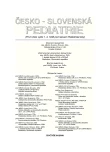-
Medical journals
- Career
Antimicrobial Resistance of Uropathogens in Children with Febrile Urinary Tract Infections
Authors: G. Koľvek 1; Ľ. Podracká 1; K. Čurová 2; L. Siegfried 2
Authors‘ workplace: I. Klinika detí a dorastu UPJŠ LF a DFN, Košice prednostka prof. MUDr. Ľ. Podracká, CSc. 1; Ústav lekárskej mikrobiológie a klinickej mikrobiológie UPJŠ LF, Košice prednosta prof. MUDr. L. Siegfried, CSc. 2
Published in: Čes-slov Pediat 2009; 64 (9): 392-399.
Category: Original Papers
Overview
Febrile urinary tract infections belong to the most common bacterial infections in childhood. Renal scaring could develop as a consequence of severe infection therefore an early diagnose and suitable empiric antibiotic treatment is mandatory. Choice of antibiotic is based on the epidemiologic data as well as surveillance of antimicrobial resistance patterns of common uropathogens.
The aim of the retrospective study was to analyze bacterias isolated from 68 children with febrile urinary tract infections (UTI) and to asses the efficacy of antibiotic treatment. Obtained results were evaluated according to the child’s age and occurrence of congenital urinary tract (UT) anomalies. Escherichia coli (E. coli) was the leading uropathogen (56 children, 82.4%) in all groups of children. Patients with congenital UT anomalies showed both significantly higher proportion of non-Escherichia coli (non-E. coli) infections (p<0.033) and antibiotic resistance (CIP 18.8% vs. 2.8%, p<0.025; CTX 21.9% vs. 5.6 %, p<0.047), also the tendency of higher resistance especially to COT (46.9% vs.19.4%, p<0.024) and GEN (28.1% vs. 0%, p<0.001) was present compared to children without anomalies. In E. coli group without congenital UT anomalies antibiotic resistance was minimal (GEN 0%, CTX 3.0% a CIP 0%) except for COT (18.2%) and AMP (28.1%).Conclusions:
Our data support that empirical therapy of febrile UTI with cephalosporins of third generation and aminoglycosides is suitable, since bacterial strains shows good susceptibility to the both antibiotics. Patients with congenital UT anomalies have more common non-E. coli infections and higher resistance patterns against antimicrobial agents as well.Key words:
acute pyelonephritis, antibiotic resistance, congenital urinary tract anomalies
Sources
1. Shaikh N, Morone NE, et al. Prevalence of urinary tract infection in childhood: a meta-analysis. Pediatr. Infect. Dis. J. 2008;27(4): 302–308.
2. Stockland E, Hellstrom M, et al. Renal damage one year after first urinary tract infection: role of dimercaptosuccinic acid scintigraphy. J. Pediatr. 1996;129 : 815–820.
3. Benador D, Neuhaus T, et al. Randomised controlled trial of 3 day versus 10 day intravenous antibiotics in acute pyelonephritis: effect on renal scarring. Arch. Dis. Child. 2001;84 : 241–246.
4. Rushton HG, Majd M. Renal scarring following reflux and nonreflux pyelonephritis in children: a follow-up study using 99mTc DMSA renal scintigraphy. J. Urol. 1992;147 : 1327–1332.
5. Wiswell TE. The prepuce, urinary tract infections and the consequences. Pediatrics 2000;105 : 860–862.
6. Svanborg C, Bergsten G, Fischer H, et al. Uropathogenic Escherichia coli as a model of host–parasite interaction. Current Opinion Microbiol. 2006;9 : 33–39.
7. Dolezel Z, Mach V, Kopecna L, Starha J, Dostalkova D. Diagnosis of acute pyelonephritis in childhood: comparison of ultrasonographic examination and renal scintigraphy using 99mTc DMSA. Bratisl. lek. Listy 2000;101(9): 495–498.
8. Jodal U, Lindberg U, Lincoln K. Level diagnosis of symptomatic urinary tract infections in childhood. Acta Paediatr. Scand. 1975;64 : 201–208.
9. Clinical and Laboratory Standards Institute. Performance standards for antimicrobial susceptibility testing. 16th informational supplement. M100-S16. CLSI, Wayne, P.A., 2006.
10. Garcia MI, Labigne A, Le Bougenec CL. Nucleotide sequence of the afimbrial-adhesin-encoding afa-3 gene cluster and its translocation via flanking IS1 insertion sequences. J. Bacteriol. 1994;176 : 7601–7613.
11. Yamamoto S, Terai A, Yuri K, et al. Detection of virulence factors in Escherichia coli by multiplex polymerase chain reaction. FEMS Immuno. Med. Microbiol. 1995;12 : 85–90.
12. Kovács L, Podracká Ľ, Jankó V. Infekcia močových ciest u detí. Pediatr. pre Prax 2008; 4 : 220–224.
13. Jahnukainen T, Chen M. Mechanisms of renal damage owing to infection. Pediatr. Nephrol. 2005;20(8): 1043–1053.
14. Beetz R, Bachmann H, et al. Urinary tract infections in infants and children – a consensus on diagnostic, therapy and prophylaxis. Urologe A 2007;46(2): 114–118, 120–123.
15. Feber J, Špatenka J, Seeman T, et al. Urinary tract infections in pediatric renal transplant recipients – a two center risk factors study. Pediatr. Transplantation DOI: 10.1111/j.1399-3046.2008.01079.x.
16. Fanos V, Khoory BJ. Antimicrobial survey of urinary tract isolates from a pediatric department. J. Chemother. 1999;11(4): 255–259.
17. Prelog M, Schiefecker D, Fille M. Febrile urinary tract infection in children: ampicillin and trimethoprim insufficient as empirical mono-therapy. Pediatr. Nephrol. 2008;23 : 597–602.
18. Haller M, Brandis M, Berner R. Antibiotic resistance of urinary tract pathogens and rationale for empirical intravenous therapy. Pediatr. Nephrol. 2004;19 : 982–986.
Labels
Neonatology Paediatrics General practitioner for children and adolescents
Article was published inCzech-Slovak Pediatrics

2009 Issue 9-
All articles in this issue
- Antimicrobial Resistance of Uropathogens in Children with Febrile Urinary Tract Infections
- The Relevance of Routine Haemostasis Testing in Children Prior to Adenoidectomy and/or Tonsillectomy
- „Café-au-lait“ Maculae in the Diagnostics of Child Tumorous Diseases
- Suggested Instructions for Prevention, Diagnostics and Therapy of Child Obesity
- New Classification of the Disorders of Sexual Development (DSD)
- Czech-Slovak Pediatrics
- Journal archive
- Current issue
- Online only
- About the journal
Most read in this issue- „Café-au-lait“ Maculae in the Diagnostics of Child Tumorous Diseases
- New Classification of the Disorders of Sexual Development (DSD)
- Antimicrobial Resistance of Uropathogens in Children with Febrile Urinary Tract Infections
- The Relevance of Routine Haemostasis Testing in Children Prior to Adenoidectomy and/or Tonsillectomy
Login#ADS_BOTTOM_SCRIPTS#Forgotten passwordEnter the email address that you registered with. We will send you instructions on how to set a new password.
- Career

